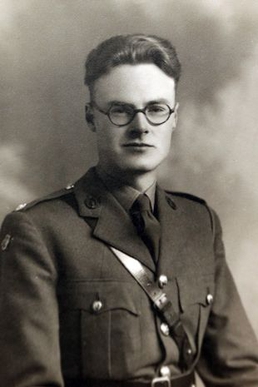Eric Lomax facts for kids
Quick facts for kids
Eric J Lomax
|
|
|---|---|
 |
|
| Born |
Eric Sutherland Lomax
30 May 1919 Edinburgh, Scotland
|
| Died | 8 October 2012 (aged 93) Berwick-upon-Tweed, England
|
| Nationality | British |
| Occupation | Military officer, author |
| Known for | The Railway Man |
| Spouse(s) |
Patti Lomax
(m. 1983) |
Eric Sutherland Lomax (born May 30, 1919 – died October 8, 2012) was a British Army officer. He was sent to a Japanese prisoner-of-war camp in 1942 during World War II. He is best known for his book, The Railway Man. This book tells his story from before, during, and after the war. It won important awards like the 1996 NCR Book Award.
Contents
Eric Lomax's Early Life
Eric Lomax was born in Edinburgh, Scotland, on May 30, 1919. He went to the Royal High School, Edinburgh. When he was 16, he left school. He started working at the Post Office. He became a sorting clerk and telegraphist in Edinburgh in 1936. A year later, he was promoted to a clerical job.
Military Service During World War II
In 1939, when he was 20, Eric Lomax joined the Royal Corps of Signals. This was just before World War II began. He became an officer in the army in 1940. He was part of the Royal Signals and worked with the 5th Field Regiment, Royal Artillery.
As a lieutenant, he was captured by the Japanese in February 1942. This happened after the surrender of Singapore. He became a Far East Prisoner of War. He and other prisoners were forced to march to Changi Prison. Then, they were taken to Kanchanaburi, Thailand. There, they were forced to build the difficult Burma Railway.
In 1943, Eric and five other prisoners were treated very harshly by the Kempeitai. This happened after a hidden radio was found in their camp. He was then moved to Outram Road Prison in Singapore. He stayed there for the rest of the war.
After the war, in 1946, he was recognized for his brave service as a prisoner of war. He received the Efficiency Medal in 1949. He also gained the honorary rank of captain. He left the Army in 1949.
Life After the War and His Passing
After the war, Eric Lomax found it hard to adjust to normal life. He joined the Colonial Service. He worked in the Gold Coast (now Ghana) until 1955. Later, he worked for the Scottish Gas Board. He also worked at the University of Strathclyde. He retired in 1982.
Eric Lomax was one of the first people helped by the Medical Foundation for the Care of Victims of Torture. This foundation helps people who have suffered greatly. Later in his life, he met and forgave one of the men who had treated him harshly. This man was Takashi Nagase, an interpreter from Japan. Nagase had written a book about his own war experiences. He also built a Buddhist temple to make up for his actions.
Their meeting was filmed for a documentary called Enemy, My Friend? (1995). This film won several awards. Eric Lomax passed away at the age of 93. His death was announced on October 8, 2012. He died in Berwick-upon-Tweed, England.
Eric Lomax's Personal Life
Eric Lomax loved railways and taking pictures of trains. He joined the Stephenson Locomotive Society in 1937. His love for railways lasted his whole life.
He married his first wife, Agnes, in November 1945. They had three children: Linda May, Eric, and Charmaine Carole.
In 1980, he met Patricia "Patti" Wallace, a nurse. She moved to the United Kingdom in 1982. Eric Lomax later married Patti in 1983.
His Autobiography and the Films
Eric Lomax's life story, The Railway Man, was published in 1995. John McCarthy, a journalist, called it "an extraordinary story of torture and reconciliation."
His story was made into a BBC television drama in 1995. It was called Prisoners in Time. John Hurt played Eric Lomax in the show.
A movie based on his book, also called The Railway Man, came out in 2013. Colin Firth played the older Eric Lomax. Jeremy Irvine played him when he was younger. Nicole Kidman played Patti, his wife. The film shows his time as a prisoner of war. It also shows his later life and his meeting with his former captor.
Works by Eric Lomax
- The Railway Man (ISBN: 0-09-958231-7)

